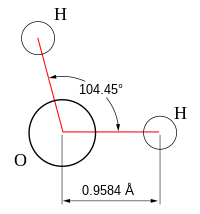
Molecular geometry is the way atoms are arranged in a molecule. The three-dimensional arrangement determines many properties of that molecule. There are many different molecular structures. They are organised by the number of atoms involved and the angles between the bonds.

The wide variety of different molecular structures depends on the number of atoms involved as well as the number of electron pairs, and these also determine the bond angles of the atoms. For example, a linear molecule will have a bond angle of 180° because the two atoms bonded to the central atom of a molecule are separated at a maximum angle of 180° equally opposite to each other. Bent molecules will have a bond angle of less than 180° but still have only two atoms bonded to the central atom of a molecule. That is because bent molecules have got electron pairs in the central atom that count as the electrons that will be separated from other atoms bonded to it.
Other shapes include:
![]() Media related to Molecular geometry at Wikimedia Commons
Media related to Molecular geometry at Wikimedia Commons
| |
| Coordination number 2 |
|
| Coordination number 3 |
|
| Coordination number 4 |
|
| Coordination number 5 |
|
| Coordination number 6 |
|
| Coordination number 7 |
|
| Coordination number 8 |
|
| Coordination number 9 |
|